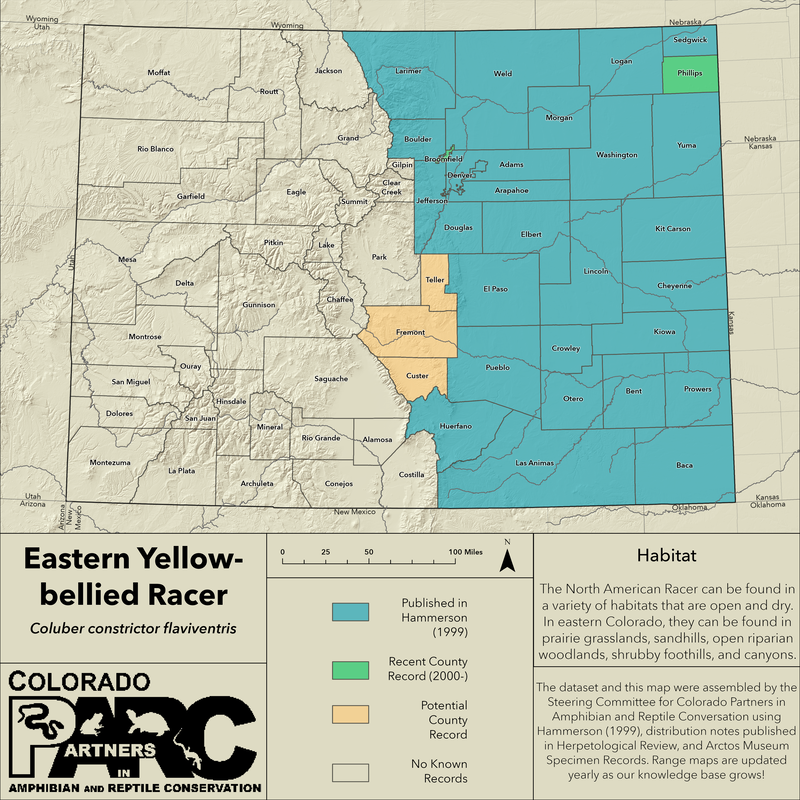General Distribution: C. constrictor ranges from California as far north as Southern British Columbia, extreme southern Saskatchewan and North Dakota over to the southern Great Lakes region, New York, and New England up to southern Maine, extending south through most of the United States to northeastern Mexico and continuing to Guatemala (Ernst & Ernst 2003).
Conservation Status: Designated as a Non-game Species in Colorado. Please click here for State of Colorado regulations regarding this species. The Speckled Kingsnake has a global status of G5 (globally secure) and a state status in Colorado of S5 (state secure; NatureServe). Because the North American Racer appears to be tolerant of some human impact on its habitat and is fairly versatile, this species occupies a vast majority of its historic range in Colorado (Hammerson 1999). The abundance of C. constrictor is difficult to assess, but the species is thought to be locally common in many areas. Yet, extensive/intensive agricultural development has eliminated or reduced the habitat suitable for C. constrictor in some areas. Causes of death over the Great Plains region include mowing machines, prescribed prairie burns, fearful humans, and road related deaths (Hammerson 1999).
Diagnostic Features
- An overall slender species.
- Nostril bordered by two separate scales.
- Relatively large eyes.
- Smooth dorsal scales.
- Dorsal scale count is 15 just anterior to (in front of) the vent.
- Divided anal plate.
- Females grow larger than males.
Coloration / Markings
- There is considerable color variation throughout the extensive range of this species; in Colorado, most adults are a uniform olive or brown with a yellow belly.
- Young have dorsal rows of 45-75 dark gray, brown, or reddish brown blotches on a lighter gray or brown background color and a series of dark brown spots on their sides and venter.
- When individuals reach 70-80 cm in total body length (TBL), their juvenile pattern usually disappears completely and are gradually replaced by the uniform adult coloration.
Size: Adult C. constrictor is a relatively large snake that can grow to a TBL of 191.1 cm. In Colorado, adults often grow to a snout vent length (SVL) of 56-82 cm. Females grow larger than males in this species. Males have a tail length (TL) making up 16-29% of their TBL and females have a TL making up 19-29% of their TBL. Hatchlings are an average of 15.2 to35.5 cm long (Ernst & Ernst 2003).
Habitat: The North American Racer can be found in a variety of habitats that are open and dry. In eastern Colorado, the North American Racer can be found in prairie grasslands, sandhills, open riparian woodlands, shrubby foothills, and canyons. In western Colorado, habitats include semi-desert shrublands and lowland riparian habitats as well as adjacent areas in valleys and canyon bottoms (Stebbins, 2003). Occasionally, North American Racers will reside in rocky pinon-juniper woodlands bordering valley bottoms in Western Colorado also. Throughout the state, this species can be found where farming and ranching areas are mixed with patches of undisturbed habitat (Hammerson 1999). This species requires spaces to retreat to and those can include mammal burrows, rocks and crevices, rotting logs and stumps, piles of vegetation, and other debris (Ernst & Ernst 2003). Furthermore, dehydration is a problem facing C. constrictor and so it will often reside in a place with an available water source. Elsewhere, C. constrictor habitat includes open hardwood and pine forests, brushy areas, sagebrush flats, scrub and prairie grasslands, meadows, old fields, and swamp and marsh boarders at elevations of sea level to over 2,100 meters.
Activity: Annual activity of the North American Racer usually begins in April in Colorado. In the early fall, around September and October, most of the active individuals are hatchlings, while most adults cease activity. Daily activity may begin as early as 8:30 am in the summer in ends when Racers can no longer maintain a body temperature of 32 degrees Celsius (Hammerson 1999). These snakes are diurnal and poke their heads out of their burrows to bask for half an hour in the morning. Later, they emerge completely and bask for about a half hour more (Ernst and Ernst 2003). They can move quickly over the ground and are also adept tree climbers. During hot summer weather, this species reduces its activity to midmornings and late afternoons. C. constrictor will also become inactive when digesting food and just prior to a skin shedding (Hammerson 1999). Winter is spent below ground in hibernating sites that include deep rock crevices, mammal burrows, and dens beneath buildings or in structures. In these dens, the North American Racer can be found in aggregations that may include other species (Stebbins, 2003).
Reproduction: Males mature in 11 months to 2 years at TBL of 50-68 cm however; males will not mate until at least their second spring (Ernst & Ernst 2003). Females mature in 2 to 3 years of age at TBLs of 50-71 cm (Ernst & Ernst 2003. Males find females by following their scent trails. In Colorado, most mating probably occurs in May and June (Hammerson 1999). Courtship can occur on the ground or aboveground in vegetation (Hammerson 1999). Female reproduction is annual with a single clutch each year that is dependent on the size of the female. Longer and older females produce larger clutches and clutch sizes are relatively large in the Great Plains region at 9-14 eggs. However, in western Colorado and Utah, C. constrictor reportedly produces smaller clutches at 4-10 eggs (Stebbins 2003). Egg-laden females can be found in mid-June in Colorado and the gestation period for eggs in the western U.S. ranges from 43-63 days (Hammerson 1999). Eggs are laid in a nest from late June to mid-July with some clutches laid as late as early August. Also, some females will share a communal nest. Eggs begin hatching around mid-August and hatchlings are often observed in Colorado in late August to September (Hammerson 1999).
Feeding & Diet: Despite its scientific name, C. constrictor does not constrict its prey. The racer uses scent and sight to detect its prey and will chase after it to seize it with its mouth. When captured, their prey may be crushed in their jaws or swallowed alive, sometimes by pinning the prey to the ground with a loop of the snake’s body. Most of its prey is caught aboveground where the North American Racer can maintain its maximum speed and agility (Hammerson 1999). C. constrictor is an opportunistic feeder that preys upon small mammals such as shrew, cottontails, squirrels, mice and voles; birds and their eggs; reptiles including small turtles, lizards, and their eggs, and smaller snakes and their skins; fish eggs; insects, especially grasshoppers and crickets in the Great Plains region; and spiders. Young North American Racers eat insects, small lizards and snakes, and young mice (Ernst and Ernst 2003).
Defenses from Predation: Predators of the North American Racer most likely include carnivorous mammals and predatory birds such as crows and hawks. To defend themselves, this species will first flee quickly but if trapped, will coil rapidly, vibrate the tail, strike, and bite viciously. When handled, adults generally thrash back and forth and attempt to bite. They may also release feces and odorous fluid from the cloacal sacs. If aggressive behavior does not drive away their enemy, some individuals will feign death (Ernst and Ernst 2003).
Cited & Additional Resources
Ernst, C. H., and E. M. Ernst. 2003. Snakes of the United States and Canada. Simthsonian Books, Wsahington and London. 77 pp.
Hammerson G. A. 1999. Amphibians and reptiles in Colorado. 2nd ed. University Press of Colorado, Boulder, Colorado. 292 pp.
Stebbins, R. C. 2003. Western reptiles and amphibians. 3rd ed. Houghton Mifflin Company, New York, New York. 351 pp.
Hammerson G. A. 1999. Amphibians and reptiles in Colorado. 2nd ed. University Press of Colorado, Boulder, Colorado. 292 pp.
Stebbins, R. C. 2003. Western reptiles and amphibians. 3rd ed. Houghton Mifflin Company, New York, New York. 351 pp.
Account compiled by: Beth Wittmann
Reviewed by: Lauren Livo (text)
Last updated: 4/13/2022 by Rémi Pattyn
Reviewed by: Lauren Livo (text)
Last updated: 4/13/2022 by Rémi Pattyn
Suggested Citation
Colorado Partners in Amphibian and Reptile Conservation. 2015. Species account for North American Racer (Coluber constrictor). Compiled by Beth Wittmann. http://www.coparc.org/north-american-racer.html [accessed date here]. Editor: Lauren Livo.
Colorado Partners in Amphibian and Reptile Conservation. 2015. Species account for North American Racer (Coluber constrictor). Compiled by Beth Wittmann. http://www.coparc.org/north-american-racer.html [accessed date here]. Editor: Lauren Livo.


